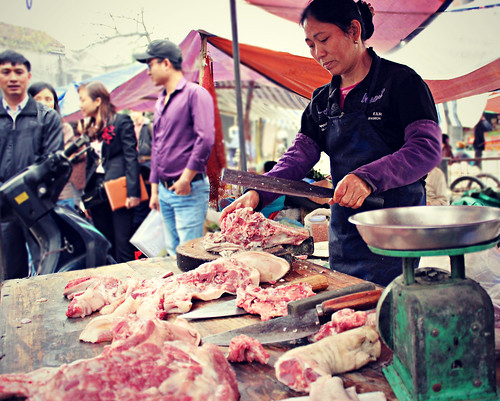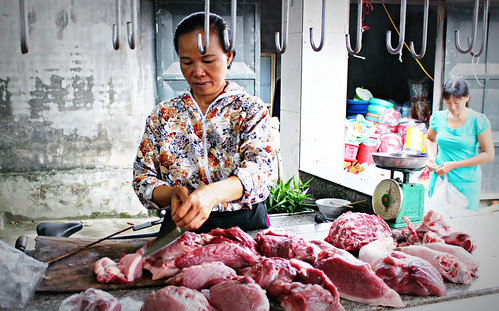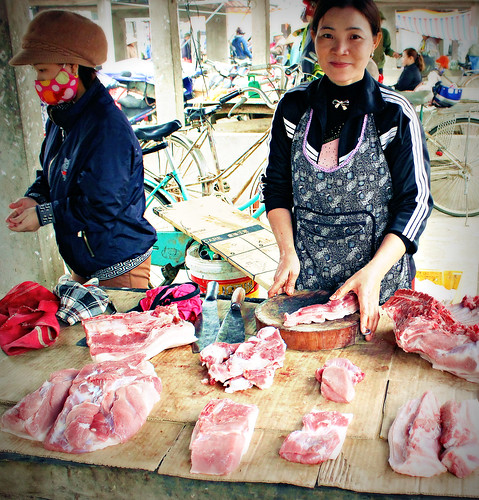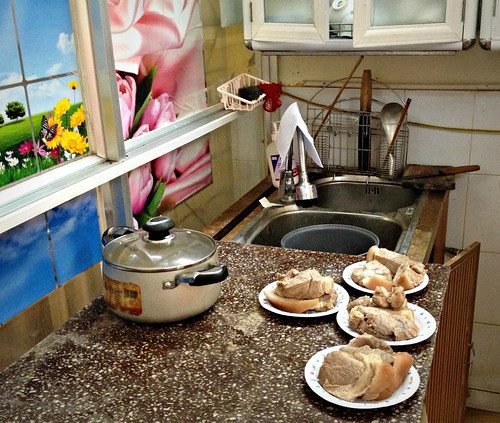Selling pork at a traditional ‘wet’ market in Hung Yen province, northern Vietnam (photo credit: ILRI/HUPH/Ngan Tran).
Pork meat sold in Vietnam has been found by researchers to commonly carry bacteria that could cause disease—but they also found that the risk of that meat sickening people is largely reduced due to the Vietnamese habit of buying very fresh meat and cooking it shortly thereafter.
The research results indicate ways that the safety of pork meat can be even further improved in this fast-growing and -evolving market. The bottom line is that ensuring safe pork consumption in Vietnam is very important—and very doable.
Conspicuous (pork) consumption
Pigs and pig keeping, and pork and pork eating, are ubiquitous in Vietnam, where pork remains the favoured meat—the food choice of both the poor and the rich, of the rural farm worker and the urban elite. Pork is consumed daily and widely in Vietnamese households, accounting on average for about 40% of household expenditures on meat.
With the country’s rising incomes boosting household expenditures on food, demand for pork has been increasing substantially in recent years, spurring increases in national pig populations and sales. There is a great scope for future increases in supply by the country’s millions of small-scale pig producers.
The typical Vietnamese food consumer is an exemplar of what might be called a ‘farmhouse fresh’ fetish, except that freshness is responsible for much of the safety as well as the deliciousness of Vietnamese dishes. Researchers have found freshness to be the most preferred attribute of pork for Vietnamese consumers, with pork meat typically being purchased very fresh every day.
Despite the expansion of modern retail outlets in big cities, traditional outlets ranging from temporary neighbourhood stalls to permanent open structures remain the preferred shopping channels for fresh pork for most consumers. While scenes of pigs being dispatched nearby these commonplace ‘wet’/traditional markets are not for the faint-hearted, the fact that the Vietnamese prefer their pork particularly fresh, and tend to cook it quickly after buying it, greatly increases the safety of consuming pork in this country. Furthermore, given this consumer preference for fresh meats and traditional outlets, Vietnam’s smallholder pig keepers can exploit the rising demand for pork to their advantage by increasing their participation in supply chains serving temporary and permanent open markets.
But there’s the rub. Food safety is a hot-button issue in Vietnam. Raising concerns over the safety of pork risks raising public alarm, which could in turn damage both the nutrition and livelihoods of many of the country’s poorest people.
Pork is eaten daily by most people in Vietnam (photo credit: ILRI/HUPH/Ngan Tran).
Pig and pork research
Recent research evidence is helping Vietnamese officials to better understand and manage pork safety in the country.
Recent studies were made of the safety of pork sold in wet markets in the northern Red River Delta (Hung Yen) and north-central (Nghe An) provinces of Vietnam. Many pork products were found to contain Salmonella and other kinds of bacteria that can make people ill. Also commonly found in the meat products were residues of antibiotic drugs that should be reserved for medical use only. This indicates that the pigs were treated with antibiotics whose use in animal production is helping to speed the development of bacterial resistance to those drugs used to treat people and animals alike. On the positive side, the levels of heavy metals such as arsenic, cadmium, lead and mercury—naturally occurring chemical compounds whose accumulation in the body can lead to harmful effects over time—found in the pork products were within acceptable limits.
The blurred boundaries between medical and veterinary affairs work to the consumer’s advantage here.
The further good news is that the human health risks posed by the presence of both harmful bacteria and antibiotic residues in Vietnamese pork can be managed. Happily, this means that the country’s many pork lovers need not curtail their pork consumption. That’s because (1) foodborne diseases are largely preventable and (2) the use of antibiotics of medical importance in the raising of pigs—a practice that risks making standard medical treatments obsolete, enabling common bacteria to once again become lethal weapons for people—can, and is being, curtailed. The research reported on here identifies several ways that both these risks to public health can be further minimized.
Pork is an affordable as well as favourite protein source, typically eaten daily with steamed rice and vegetables. The growing concern over unsafe pork sold in Vietnam’s markets could cause people to reduce their pork consumption, harming the nutritional status of the poor as well as the livelihoods of many small-scale pig producers, who supply 80% of the pork sold in the country.
In Vietnam as elsewhere, the future, as they say, may already be here but it is unevenly distributed.
For pork consumption to continue to benefit Vietnam’s many low- as well as middle–high-income pork consumers and pig producers alike, pork meat must be made safe—and, as important, must be perceived by consumers to be safe.
A major constraint to the creation of a safe and trusted pork supply is a dearth of reliable information on, and understanding of, the hazards present in pork and, most importantly, the risks that these hazards pose to human health. While consumers tend to worry most about the possible presence of chemicals in the pork they eat, they often under-estimate the risks posed by the presence of bacteria, viruses and parasites.
Scientists from the Center for Public Health and Ecosystem Research (CENPHER) of the Hanoi University of Public Health (HUPH) and the International Livestock Research Institute (ILRI) and other partners have carried out research for the last four years within a PigRISK project (Reducing disease risks and improving food safety in smallholders pig value chains in Vietnam) funded by the Australian Centre for International Agricultural Research (ACIAR). In Feb 2017, the researchers published two scientific articles describing this project’s results in Hung Yen and Nghe An provinces in a supplement of the International Journal of Public Health: Health and social determinants of health in Vietnam: Local evidence and international implications. These papers shed much-needed light on the public health risks of consuming pork and the practical actions needed to reduce them.
Selling pork at a traditional ‘wet’ market in Hung Yen province, northern Vietnam (photo credit: ILRI/HUPH/Ngan Tran).
Low chemical risk in pork consumption
One of these articles (Exposure assessment of chemical hazards in pork meat, liver, and kidney, and health impact implication in Hung Yen and Nghe An provinces, Vietnam) reports the results of analyzing 514 samples of pig feed, meat, liver and kidney for antibiotics and heavy metals collected from April 2014 to January 2015.
Chloramphenicol, however, an antibiotic used to treat bacterial infections in humans but banned for veterinary use in Vietnam, was found in 11% of packaged feed and 4% of pork samples. While chloramphenicol residues in pork are unlikely to make people ill, they are a concern because they indicate that some pigs are being treated with this antibiotic. As mentioned, using chloramphenicol in livestock production systems could hasten the development of drug resistance in bacteria, making treatment of bacterial infections in people more difficult and expensive in future.
In their paper, the food safety researchers noted that in Vietnam, as elsewhere, a common government response to the use of banned chemicals and antibiotics like chloramphenicol in feeds or other products is to recall those products and/or to fine their sellers and/or distributors. Use of such banned substances in feeds and foods was made a criminal act in Vietnam only recently, when use of such products in animal husbandry was made a punishable offence starting 1 Jul 2016. But draconian regulatory and criminal instruments are unlikely to succeed.
Experience from other countries indicates that blunt ‘command-and-control’ instruments that rely on detection and punishment are less effective than regulations and incentives that motivate the food industry to take greater responsibility for producing safe food.
In their paper, the researchers argued for employing effective risk communication strategies by publicizing the relatively low levels of chemicals they found in the pig feed and pork they sampled in this study while also emphasizing the need for pig producers to stop using antibiotics now banned by the Vietnamese government for use in animal husbandry and to stop using beta-agonist growth promoters, which are also banned.
Poor smallholders are unlikely to take up ‘best’ livestock management practices that reduce the need for antibiotics without being given adequate support and incentives to do so.
Key to risk communications, the researchers said, is to do a better job of educating the public about the real risk of consuming pork contaminated by Salmonella and other bacteria.
Daily pork being cooked in the home in Vietnam (photo credit: ILRI/HUPH/Ngan Tran).
Bacterial risk in pork consumption
The other research paper recently published (Quantitative risk assessment of human salmonellosis in the smallholder pig value chains in urban of Vietnam) provides results of a study to quantify the risk of people becoming infected with Salmonella from consuming boiled pork in Hung Yen Province, with a particular focus on smallholder pig value chains. This is the first quantitative assessment of microbial risk in food in Vietnam.
Salmonella is a common foodborne pathogen whose infection in humans can lead to diarrhoea, abdominal pain, fever and septicaemia. Some strains can cause death in as many as 3 in 100 infected people. From Apr 2014 to Feb 2015, the researchers analyzed 302 samples (swabs from the floors of pig pens, slaughterhouse carcasses and cut pork meat) using a quantitative microbial risk assessment (QMRA).
The study found Salmonella in the samples collected as follows: 33% from swabs of pig pen floors, 42% from slaughterhouse carcasses and 44% from cut pork meat. From the QMRA results, the researchers estimated that pork eaters in Hung Yen Province face a 18% probability of acquiring salmonellosis from consuming boiled pork in a given year. This figure is much higher than that cited in a 2015 report from the World Health Organization (WHO), which estimated a 1% prevalence in Asian countries, including Vietnam. However, the authors of the WHO report point out their estimate is very much on the low side (WHO’s estimate for North America is also low—at least five times lower than official North American figures).
The researchers who published the Hung Yen pork study recommend practical ways of improving pork-handling practices in both markets and households as well as other measures that can improve pork safety. Such measures are being addressed in a new research project (SafePORK) being developed by ILRI in close partnership with research institutions, private-sector companies and relevant authorities such as Task Force of Risk Assessment for Food Safety in Vietnam.

Selling pork at a traditional ‘wet’ market in Hung Yen province, northern Vietnam (photo credit: ILRI/HUPH/Ngan Tran).
Better risk communications for better food safety in Vietnam
The two recently published scientific studies described above, by demonstrating the differential importance of chemical and biological hazards in pork consumed in two provinces of Vietnam, serve as a cautionary tale about public misconceptions of food safety generally. While lay publics worldwide tend to worry more about chemical than about biological hazards, a mass of evidence from many countries shows that this is a mistake.
What people worry about and what makes them sick are not the same. What’s needed are approaches to food safety based on solid scientific evidence, not public anxieties alone.
Whereas the major concerns and focus of food safety experts are biological hazards (viruses, bacteria, parasites), policymakers and the general public are mostly concerned about chemicals found in foods as well as novel food processes such as irradiation and biotechnologies.
The pork safety research evidence described here confirms that in the study area sampled, the burden of the biological hazard (Salmonella) was orders of magnitude greater than that of the chemical hazards.
Researchers and research communicators and government officials obviously need to do a much better job of communicating to consumers, traders, farmers and policymakers the realities of food safety risks and how best to manage the real risks those realities pose.
Takeaways for Vietnam
For Vietnam, where food safety matters are matters of big public concern and where government agencies are looking for the most rational investment of scarce resources to mitigate food risks to public health, this latest research evidence provides insights into how food-borne diseases in the country can be greatly reduced.
While ‘zero tolerance’ is not an option, practical and highly effective risk mitigation methods include maintaining or putting in place basic food safety practices along pig production and pork processing, selling, cooking and eating to minimize the risk of infection with Salmonella and ensuring that pig feeds are free of banned chemicals.
Read the research papers
Exposure assessment of chemical hazards in pork meat, liver, and kidney, and health impact implication in Hung Yen and Nghe An provinces, Vietnam, by Tran Thi Tuyet-Hanh (Hanoi University of Public Health, Hanoi), Dang Xuan Sinh (CENPHER, Hanoi), Pham Duc Phuc (CENPHER), Tran Thi Ngan (CENPHER), Chu Van Tuat (Ministry of Agriculture and Rural Development, Hanoi), Delia Grace (ILRI), Fred Unger (ILRI) and Hung Nguyen-Viet (ILRI), International Journal of Public Health, Feb 2017, Volume 62, Supplement 1, pp 75–82.
Quantitative risk assessment of human salmonellosis in the smallholder pig value chains in urban of Vietnam, by Sinh Dang-Xuan (CENPHER, Hanoi), Hung Nguyen-Viet (ILRI), Fred Unger (ILRI), Phuc Pham-Duc (CENPHER), Delia Grace (ILRI), Ngan Tran-Thi (CENPHER), Max Barot (ILRI), Ngoc Pham-Thi (National Institute of Veterinary Research, Hanoi) and Kohei Makita (ILRI and Rakuno Gakuen University, Japan), International Journal of Public Health, Feb 2017, Volume 62, Supplement 1, pp 93–102.
Related materials
Read other materials about the PigRisk project (‘Reducing disease risks and improving food safety in smallholder pig value chains in Vietnam’).
Or visit the PigRisk wiki site.
For further information
Contact Fred Unger, ILRI senior scientist, f.unger@cgiar.org




Reblogged this on AgHealth.
Reblogged this on ILRI Asia.
Reblogged this on ILRI Asia.